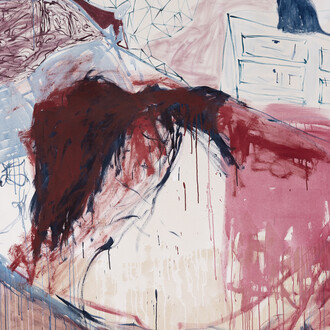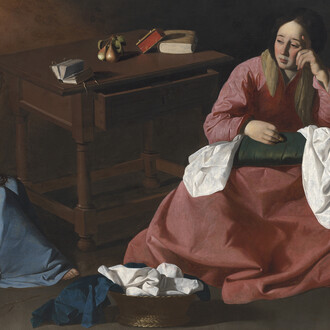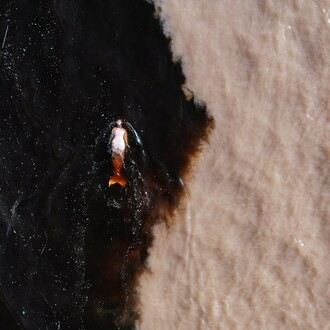The rainbow is a bridge between everyone and everything.
(Ugo Rondinone)
Ugo Rondinone’s latest exhibition at Sadie Coles HQ, the rainbow body, features a series of figurative sculptures within a fluorescent environment. The walls, floors and ceiling of the gallery have been finished in rainbow shades that mirror the sculptures’ own colours, engendering a push-pull dynamic between the individual figure and the landscape of the exhibition. The display also includes bronze sculptures of candles that restate the larger theme of suspended time.
Combining transcendental radiance with a sense of introspection, the rainbow body reprises several of the core concerns of Rondinone’s practice: the interplay of part and whole, for example, or the link between the immediate moment and cosmic time. The polychrome figures – spread across the floor of the main gallery – have their origins in his nude series of 2010, a group of fourteen casts of seated or crouching dancers, each assembled from smaller wax sections (in the original group, clear wax was mixed with earth sourced from each of the seven continents). Naked apart from head coverings, the dancers are captured in moments of repose, their eyes closed. The joins between the body parts are left visible, in a conscious subversion of the casts’ realism.
The nude (rainbow) series marks an evolution of the original sculptures. While the earlier nudes were bound to the earth in their make-up, the prismatic coloration of the rainbow figures betokens a state of transfiguration – the physical body dissolving into light. In this, there is an allusion to the ‘rainbow body’ phenomenon of Buddhism and its antecedents, the highest level of spiritual attainment, whereby the elements of the mortal body transform into the lights of the spectrum before evanescing into pure light.
The rainbow shades bind the figures into an immersive system, acting as a “bridge between everything and everyone”, in Rondinone’s words, with the colour-filled gallery coming to resemble a stage – a site of possibility. At the same time, each figure signifies interiority, conveying a distinct psychological presence. The dancers are, in Rondinone’s words, “passive, just being themselves without any activity or conscious evaluation.” Historical time collapses into the present moment, in a way that resonates with the artist’s wider practice – whether his iterative paintings of sunrises, his life-size casts of olive trees, or his sculptural group of trompe l’oeil clowns (begun in 2000) imagined in various states of rest and slumber.
The second gallery contains a constellation of sculptures of candles, arrayed across the floor in the style of votive offerings. Like the dancers (each captured at the height of youth and physical prowess), these are markers of time: half-metamorphosed objects, rendered statuesque and changeless. Forming part of Rondinone’s long-running still.life series of mundane objects transmuted into bronze, the candles express an oscillation between the everyday – seeming almost bathetic in their modest scale – and the transcendental. Their bronze medium moreover suggests a displacement of materials between the two bodies of work in the exhibition: bronze would be a more ‘classical’ material for the human figures, wax a more probable one for candles.
Giving emblematic expression to the theme of time, a stained-glass clock illuminates the gallery from one end. It has been liberated of hands, as though time had dispersed or condensed into a singularity. Evoking the primordial clock of the sun, the window symbolises the interconnectedness of nature and humanity, a concept that has underpinned Rondinone’s art from its earliest beginnings.
(Text by James Cahill)
















